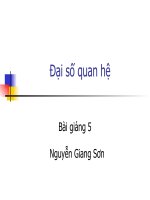Developmental disturbances of the teeth (loạn dưỡng hệ răng)
Bạn đang xem bản rút gọn của tài liệu. Xem và tải ngay bản đầy đủ của tài liệu tại đây (9.83 MB, 114 trang )
DEVELOPMENTA
L
DISTURBANCES
OF THE TEETH
Prepared by:
Dr. Rea Corpuz
Developmental
Disturbances
(1) Size
(2) Number and Eruption
(3) Shape/Form
(4) Defects of Enamel and Dentin
Size
Microdontia
Macrodontia
Siz
e
Microdontia
(1) True Generalized
Microdontia
(2) Relative Generalized
Microdontia
(3) Focal or Localized
Microdontia
(1) True
Generalized
Microdontia
all teeth are smaller than
normal
occur in some cases of
pituitary dawrfism
exceedingly rare
teeth are well formed
(2) Relative
Generalized
Microdontia
normal or slightly smaller
than
normal teeth
are present in jaws that are
somewhat larger than
normal
(3) Focal/Localized
Microdontia
common condition
affects most often maxillary
lateral incisior + 3rd molar
these 2 teeth are most often
congenitally missing
(3) Focal/Localized
Microdontia
common forms of localized
microdontia is that which
affects maxillary lateral
incisior
peg lateral
instead of parallel or
diverging mesial + distal
surfaces
(3) Focal/Localized
Microdontia
sides converge or taper
together incisally
forms cone-shaped crown
root is frequently shorter
than usual
Size
Microdontia
Macrodontia
Siz
e
Macrodontia
(1) True Generalized
Macrodontia
(2) Relative Generalized
Macrodontia
(3) Focal or Localized
Macrodontia
(1) True
Generalized
Macrodontia
all teeth are larger than
normal
associated with
pituitary gigantism
exceedingly rare
(2) Relative
Generalized
Macrodontia
normal or slightly larger than
normal teeth in small jaws
results in crowding of
teeth
insufficient arch space
(3) Focal/Localized
Macrodontia
uncommon condition
unknown etiology
usually seen with
mandibular 3rd molars
Developmental
Disturbances
(1) Size
(2) Number and Eruption
(3) Shape/Form
(4) Defects of Enamel and Dentin
Number and Eruption
Supernumerary
Anodontia
Impaction
Number and Eruption
Supernumerary
results from continued
proliferation of
permanent
or primary dental lamina
to form third tooth germ
teeth may have:
• normal morphology
• rudimentary
Number and Eruption
Supernumerary
more often in permanent
dentition than primary
dentition
more in the maxilla than
in
mandible
Number and Eruption
Supernumerary
may be impacted erupted
or impacted
because of additional
tooth
bulk, it causes:
• malposition of adjacent
teeth
Number and Eruption
Supernumerary
many are impacted
• characteristically found
in cleidocranial
dysostosis
Number and Eruption
Supernumerary
Mesiodens
Fourth molar
•Maxillary Paramolar
• Distomolar or Distodens
Mandibular Premolar
Maxillary lateral incisors
Number and Eruption
Supernumerary
Mandibular central
incisors
Maxillary Premolars
Mesiodens
most common
supernumerary tooth
tooth situated between
maxillary central incisors
singly
paired
erupted or impacted
Mesiodens
small tooth
cone-shaped crown
short root
Fourth Molar
2nd most common
situated distal to 3rd molar
small rudimentary tooth,
but may be of normal size
mandibular 4th molar also is
seen occasionally, but less
common than maxillary
molar









